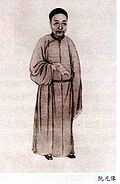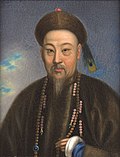
| Viceroy of Liangguang | |||||||
|---|---|---|---|---|---|---|---|
| Chinese name | |||||||
| Traditional Chinese | 兩廣總督 | ||||||
| Simplified Chinese | 两广总督 | ||||||
| |||||||
| Governor-General of Two Guang Provinces and Other Local Areas,in Charge of Military Affairs,Food and Wages and Governor Affairs (full title) | |||||||
| Traditional Chinese | 總督兩廣等處地方提督軍務、糧饟兼巡撫事 | ||||||
| Simplified Chinese | 总督两广等处地方提督军务、粮饷兼巡抚事 | ||||||
| |||||||
| Manchu name | |||||||
| Manchu script | ᡤᡠᠸᠠᠩᡩᡠᠩ ᡤᡠᠸᠠᠩᠰᡳ ᡠᡥᡝᡵᡳ ᡴᠠᡩᠠᠯᠠᡵᠠ ᠠᠮᠪᠠᠨ | ||||||
| Romanization | guwangdung guwangsi uheri kadalara amban | ||||||
The Viceroy of Liangguang,fully in Chinese as the Governor-General of Two Guang Provinces and Other Local Areas,in Charge of Military Affairs,Food and Wages and Governor Affairs,was one of eight regional Viceroys during the Ming and Qing dynasties of China. The Viceroy of Liangguang had jurisdiction of military,civil,and political affairs over then Guangdong Province and then Guangxi Province (approx. nowadays Guangdong,Guangxi,Hainan,Hong Kong,and Macau).
































